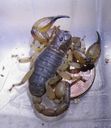Iuridae
Iuridae
Classification
- Phylum: Arthropoda
- Subphylum: Chelicerata
- Class: Arachnida
- Order: Scorpiones
- Family: Iuridae
Pronunciation
How to pronounce Iuridae: /juːˈrɪdiːiː/
These audio files are automatically generated. While they are not always 100% accurate, they are a good starting point.
Images






Summary
The family Iuridae includes a variety of scorpions, characterized by a unique tooth structure on their chelicerae. It contains 2 subfamilies and at least 36 species across 6 genera, found primarily in western regions of the Americas and parts of Eurasia.
Physical Characteristics
Members of the family Iuridae possess an enlarged tooth on the internal margin of the cheliceral movable finger, a characteristic exclusive to this family. In the genus Anuroctonus, this tooth is present only in juveniles.
Identification Tips
Look for the enlarged tooth on the cheliceral movable finger for identification, especially in juvenile Anuroctonus.
Habitat
Primarily found in western North America and western South America, as well as southwestern Eurasia.
Distribution
Western North America to western South America; southwestern Eurasia.
Diet
Scorpions in the family Iuridae are primarily carnivorous, preying on insects and other small arthropods.
Life Cycle
Information on the specific life cycle stages of Iuridae is limited, but common scorpion life stages include egg, juvenile, and adult.
Reproduction
Details specific to the reproduction of Iuridae are not provided, but scorpions generally reproduce sexually with males performing courtship rituals to attract females.
Predators
Larger arthropods, birds, mammals, and other predators may prey upon Iuridae scorpions.
Ecosystem Role
Iuridae scorpions play a role as both predators and prey within their ecosystems, helping to control insect populations.
Evolution
The family Iuridae was established by Thorell in 1876, with subsequent phylogenetic discussions resulting in taxonomic revisions.
Similar Taxa
- Caraboctoninae
Tags
- scorpions
- Iuridae
- arachnid
- taxonomy